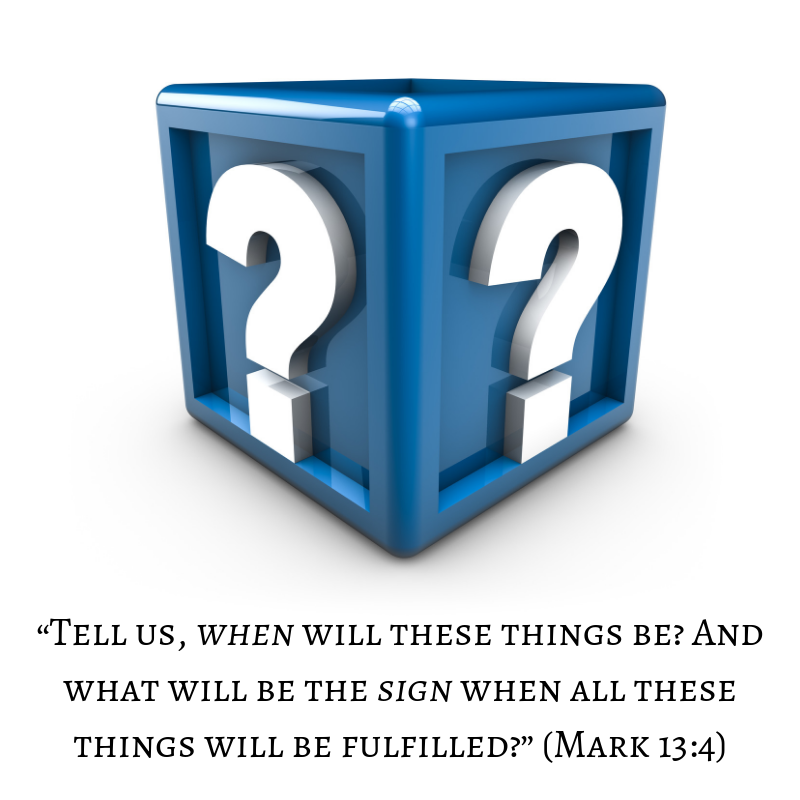
A friend recently made an interesting observation about our prophetic model (inmillennialism). We were discussing the process I used to derive it from Scripture. I have done this many times with other people. My approach has been to start with Matthew’s account of Jesus’s Olivet Discourse (Matt 24–25). This time, I began in Mark’s shorter version (Mark 13:1–37).
I made a few key points from the introduction (Mark 13:1–3). They involved the structure of the Discourse. My friend said its simplicity had escaped him in the past. He also suggested that this approach—emphasizing the simple structure in Mark’s account—might prove beneficial for my readers.
So, this post will be the first in a series on Mark’s account of the Olivet Discourse. They will be short and simple.
We will begin with the point I made to my friend. The entire Olivet Discourse comprises just three elements:
- Jesus’s prophecy about the Temple’s destruction (Mark 13:1–2)
- The disciples’ two questions about those events (Mark 13:3–4)
- Jesus’s answers to those two questions (Mark 13:5–37).
Here is Jesus’s prophecy:
Then as He went out of the temple, one of His disciples said to Him, “Teacher, see what manner of stones and what buildings are here!” And Jesus answered and said to him, “Do you see these great buildings? Not one stone shall be left upon another, that shall not be thrown down.” (Mark 13:1–2)
This prophecy is uncomplicated. It is about the destruction of the Second Temple in Jerusalem. Israel had built this Temple after they returned from Babylon, almost five centuries before Jesus was born. King Herod had renovated it during the lifetime of Jesus’s earthly parents (cp. John 2:20). Now, during the last week of his life, Jesus predicts its destruction.
After giving this prophecy, Jesus and the disciples leave the Temple and walk eastward across the Kidron valley. Their new location gives its name to Jesus’s discourse. Here is what happened:
Now as He sat on the Mount of Olives opposite the temple, Peter, James, John, and Andrew asked Him privately, “Tell us, when will these things be? And what will be the sign when all these things will be fulfilled?” (Mark 13:3–4; emphasis added)
The disciples want to know about “these things.” This phrase can only mean the events surrounding the Temple’s destruction.
These two words—“these things”—unify the Olivet Discourse. Jesus uses them twice more near the end of his answers (Mark 13:29–30). This shows his subject does not change as he moves the discussion forward to its conclusion.
The disciples’ first question about “these things” is about when they will occur. Their second question involves the sign that will accompany them.
Inmillennialism says Jesus answered these two questions in reverse order of how the disciples asked them. His answer to the sign question is in Mark 13:5–27. The answer to the when question is in Mark 13:28–37. These answers will provide subjects for future posts.
Now we have a simple question of our own. Using Jesus’s prophecy and the disciples’ two questions in Mark 13:1–4, can you detect that the Olivet Discourse is about anything other than the Second Temple’s destruction?
As you consider how to answer, please know that we plan to review the rest of the Discourse in Mark. We will ask the same question each step of the way. This will allow us to determine if and where Jesus introduces a new subject.
Please leave your answer in the comment section below.

5 comments
Dynamic simplicity. Love this brief post.
Thank you!
In this case…keep em coming
Like this approach.
Thanks for the feedback, it means a lot to me.